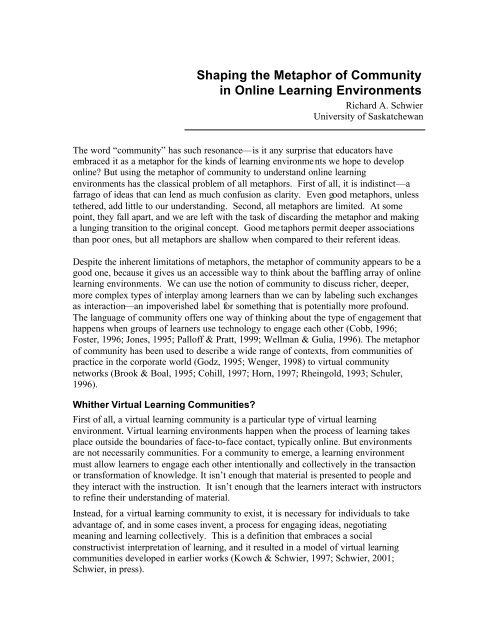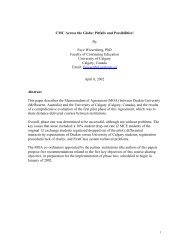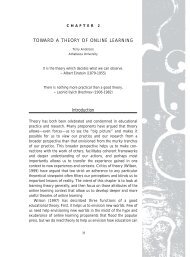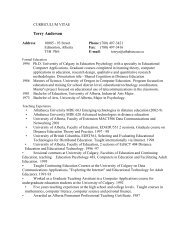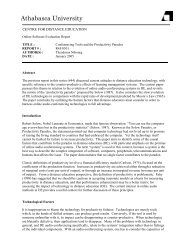Shaping the Metaphor of Community in Online Learning Environments
Shaping the Metaphor of Community in Online Learning Environments
Shaping the Metaphor of Community in Online Learning Environments
You also want an ePaper? Increase the reach of your titles
YUMPU automatically turns print PDFs into web optimized ePapers that Google loves.
<strong>Shap<strong>in</strong>g</strong> <strong>the</strong> <strong>Metaphor</strong> <strong>of</strong> <strong>Community</strong><br />
<strong>in</strong> Onl<strong>in</strong>e Learn<strong>in</strong>g <strong>Environments</strong><br />
Richard A. Schwier<br />
University <strong>of</strong> Saskatchewan<br />
The word “community” has such resonance—is it any surprise that educators have<br />
embraced it as a metaphor for <strong>the</strong> k<strong>in</strong>ds <strong>of</strong> learn<strong>in</strong>g environments we hope to develop<br />
onl<strong>in</strong>e But us<strong>in</strong>g <strong>the</strong> metaphor <strong>of</strong> community to understand onl<strong>in</strong>e learn<strong>in</strong>g<br />
environments has <strong>the</strong> classical problem <strong>of</strong> all metaphors. First <strong>of</strong> all, it is <strong>in</strong>dist<strong>in</strong>ct—a<br />
farrago <strong>of</strong> ideas that can lend as much confusion as clarity. Even good metaphors, unless<br />
te<strong>the</strong>red, add little to our understand<strong>in</strong>g. Second, all metaphors are limited. At some<br />
po<strong>in</strong>t, <strong>the</strong>y fall apart, and we are left with <strong>the</strong> task <strong>of</strong> discard<strong>in</strong>g <strong>the</strong> metaphor and mak<strong>in</strong>g<br />
a lung<strong>in</strong>g transition to <strong>the</strong> orig<strong>in</strong>al concept. Good metaphors permit deeper associations<br />
than poor ones, but all metaphors are shallow when compared to <strong>the</strong>ir referent ideas.<br />
Despite <strong>the</strong> <strong>in</strong>herent limitations <strong>of</strong> metaphors, <strong>the</strong> metaphor <strong>of</strong> community appears to be a<br />
good one, because it gives us an accessible way to th<strong>in</strong>k about <strong>the</strong> baffl<strong>in</strong>g array <strong>of</strong> onl<strong>in</strong>e<br />
learn<strong>in</strong>g environments. We can use <strong>the</strong> notion <strong>of</strong> community to discuss richer, deeper,<br />
more complex types <strong>of</strong> <strong>in</strong>terplay among learners than we can by label<strong>in</strong>g such exchanges<br />
as <strong>in</strong>teraction—an impoverished label for someth<strong>in</strong>g that is potentially more pr<strong>of</strong>ound.<br />
The language <strong>of</strong> community <strong>of</strong>fers one way <strong>of</strong> th<strong>in</strong>k<strong>in</strong>g about <strong>the</strong> type <strong>of</strong> engagement that<br />
happens when groups <strong>of</strong> learners use technology to engage each o<strong>the</strong>r (Cobb, 1996;<br />
Foster, 1996; Jones, 1995; Pall<strong>of</strong>f & Pratt, 1999; Wellman & Gulia, 1996). The metaphor<br />
<strong>of</strong> community has been used to describe a wide range <strong>of</strong> contexts, from communities <strong>of</strong><br />
practice <strong>in</strong> <strong>the</strong> corporate world (Godz, 1995; Wenger, 1998) to virtual community<br />
networks (Brook & Boal, 1995; Cohill, 1997; Horn, 1997; Rhe<strong>in</strong>gold, 1993; Schuler,<br />
1996).<br />
Whi<strong>the</strong>r Virtual Learn<strong>in</strong>g Communities<br />
First <strong>of</strong> all, a virtual learn<strong>in</strong>g community is a particular type <strong>of</strong> virtual learn<strong>in</strong>g<br />
environment. Virtual learn<strong>in</strong>g environments happen when <strong>the</strong> process <strong>of</strong> learn<strong>in</strong>g takes<br />
place outside <strong>the</strong> boundaries <strong>of</strong> face-to-face contact, typically onl<strong>in</strong>e. But environments<br />
are not necessarily communities. For a community to emerge, a learn<strong>in</strong>g environment<br />
must allow learners to engage each o<strong>the</strong>r <strong>in</strong>tentionally and collectively <strong>in</strong> <strong>the</strong> transaction<br />
or transformation <strong>of</strong> knowledge. It isn’t enough that material is presented to people and<br />
<strong>the</strong>y <strong>in</strong>teract with <strong>the</strong> <strong>in</strong>struction. It isn’t enough that <strong>the</strong> learners <strong>in</strong>teract with <strong>in</strong>structors<br />
to ref<strong>in</strong>e <strong>the</strong>ir understand<strong>in</strong>g <strong>of</strong> material.<br />
Instead, for a virtual learn<strong>in</strong>g community to exist, it is necessary for <strong>in</strong>dividuals to take<br />
advantage <strong>of</strong>, and <strong>in</strong> some cases <strong>in</strong>vent, a process for engag<strong>in</strong>g ideas, negotiat<strong>in</strong>g<br />
mean<strong>in</strong>g and learn<strong>in</strong>g collectively. This is a def<strong>in</strong>ition that embraces a social<br />
constructivist <strong>in</strong>terpretation <strong>of</strong> learn<strong>in</strong>g, and it resulted <strong>in</strong> a model <strong>of</strong> virtual learn<strong>in</strong>g<br />
communities developed <strong>in</strong> earlier works (Kowch & Schwier, 1997; Schwier, 2001;<br />
Schwier, <strong>in</strong> press).
<strong>Metaphor</strong> <strong>of</strong> community 2<br />
All <strong>of</strong> this sounds so pleasant. Communities are idealized <strong>in</strong> our m<strong>in</strong>ds, but <strong>of</strong>ten quite<br />
different <strong>in</strong> gritty experience. We th<strong>in</strong>k <strong>of</strong> communities as warm, <strong>in</strong>vit<strong>in</strong>g and supportive;<br />
<strong>the</strong> truth is <strong>of</strong>ten less favourable. Few <strong>of</strong> us actually experienced <strong>the</strong> idealized<br />
community we imag<strong>in</strong>e, yet we have little trouble extend<strong>in</strong>g <strong>the</strong> idealized version <strong>of</strong> our<br />
metaphor to virtual learn<strong>in</strong>g communities. We assume that learners will want to come<br />
toge<strong>the</strong>r, that <strong>the</strong>y will be mutually supportive, and <strong>the</strong>y will be driven to learn. But it is<br />
important to realize that communities, and particularly virtual learn<strong>in</strong>g communities, are<br />
not <strong>in</strong>herently good, desirable or ideal. Sometimes learners aren’t motivated, <strong>the</strong>y aren’t<br />
always mutually supportive and naturally collaborative, and <strong>the</strong>y don’t always br<strong>in</strong>g <strong>the</strong><br />
highest standards <strong>of</strong> mature conduct <strong>in</strong>to <strong>the</strong>ir virtual learn<strong>in</strong>g environments. In o<strong>the</strong>r<br />
words, virtual learn<strong>in</strong>g environments don’t always evolve <strong>in</strong>to virtual learn<strong>in</strong>g<br />
communities.<br />
Selznik (1996) identified seven important elements <strong>of</strong> communities: history, identity,<br />
mutuality, plurality, autonomy, participation, and <strong>in</strong>tegration. For virtual learn<strong>in</strong>g<br />
communities, I have added three elements to Selznik’s list: an orientation to <strong>the</strong> future,<br />
technology, and learn<strong>in</strong>g. These ten elements (see Figure 1) underscore <strong>the</strong> idea that<br />
communities are complex and multidimensional, and each element carries correspond<strong>in</strong>g<br />
implications for support<strong>in</strong>g learn<strong>in</strong>g <strong>in</strong> virtual contexts.<br />
Figure 1. Elements, emphases and catalysts <strong>of</strong> virtual learn<strong>in</strong>g communities (Schwier,<br />
2001).<br />
The model also describes various emphases that can exist or co-exist <strong>in</strong> virtual learn<strong>in</strong>g<br />
communities. VLCs might emphasize build<strong>in</strong>g <strong>in</strong>terpersonal relationships, mimic a geographic<br />
location, provide a place for reflection, provide a ga<strong>the</strong>r<strong>in</strong>g place for ceremony or ritual, or<br />
emphasize shar<strong>in</strong>g ideas. None <strong>of</strong> <strong>the</strong>se emphases are exclusive; most virtual learn<strong>in</strong>g<br />
communities have more than one emphasis.
<strong>Metaphor</strong> <strong>of</strong> community 3<br />
The center feature <strong>of</strong> <strong>the</strong> model <strong>of</strong> virtual learn<strong>in</strong>g communities, labeled “catalysts,”<br />
emphasizes <strong>the</strong> fundamental importance <strong>of</strong> communication to virtual communities (figure<br />
1). Communication is <strong>the</strong> brick and mortar <strong>of</strong> virtual communities, and communities<br />
only exist as long as communication is available to participants. Communication among<br />
participants results <strong>in</strong> <strong>in</strong>teraction, engagement and ultimately some measure <strong>of</strong> alignment<br />
with shared values <strong>of</strong> <strong>the</strong> community (Wenger, 1998).<br />
Build<strong>in</strong>g or Grow<strong>in</strong>g Virtual Learn<strong>in</strong>g Communities<br />
Virtual learn<strong>in</strong>g communities do not just happen; but nei<strong>the</strong>r are <strong>the</strong>y created—at least<br />
not exactly. What we are attempt<strong>in</strong>g to do as educators is promote <strong>the</strong> development <strong>of</strong><br />
virtual learn<strong>in</strong>g communities by nurtur<strong>in</strong>g <strong>the</strong> conditions under which <strong>the</strong>y can arise. We<br />
can try to seduce learners to become <strong>in</strong>volved, but ultimately it is <strong>the</strong> learners who will<br />
determ<strong>in</strong>e whe<strong>the</strong>r a virtual learn<strong>in</strong>g community emerges. Learners have control over <strong>the</strong><br />
quality <strong>of</strong> collaboration that happens onl<strong>in</strong>e, and if <strong>the</strong>y reject <strong>the</strong> <strong>in</strong>vitation to elevate<br />
<strong>the</strong>ir engagement with each o<strong>the</strong>r, we will be left with someth<strong>in</strong>g less—a cohort, not a<br />
community (Misanchuk, Anderson, Craner, Eddy and Smith, 2000).<br />
Still, <strong>the</strong>re is much that can be done to support <strong>the</strong> components <strong>of</strong> VLCs. An important<br />
over-arch<strong>in</strong>g pr<strong>in</strong>ciple to build<strong>in</strong>g a virtual learn<strong>in</strong>g community is to be deliberate, to<br />
th<strong>in</strong>k about and do th<strong>in</strong>gs purposefully to foster community growth. Certa<strong>in</strong>ly, by<br />
consider<strong>in</strong>g each <strong>of</strong> <strong>the</strong> elements <strong>of</strong> community, we can derive <strong>in</strong>structional strategies<br />
that are consistent with <strong>the</strong> elements (see Table 1).<br />
Bryce-Davis (2001) identified five critical features for build<strong>in</strong>g virtual learn<strong>in</strong>g<br />
communities: rules, roles, rounds, rituals and r<strong>in</strong>gers. Rules and roles are transparent.<br />
Learn<strong>in</strong>g communities require <strong>the</strong> establishment <strong>of</strong> rules to govern <strong>the</strong> operation <strong>of</strong> <strong>the</strong><br />
community and articulate protocols for engagement with o<strong>the</strong>rs. How restrictive <strong>the</strong><br />
rules <strong>of</strong> engagement are will probably significantly <strong>in</strong>fluence <strong>the</strong> Roles help def<strong>in</strong>e <strong>the</strong><br />
activities carried out <strong>in</strong> learn<strong>in</strong>g communities and set out expectations for participation.<br />
The notions <strong>of</strong> rounds, r<strong>in</strong>gers and rituals are particularly important, it seems, for learn<strong>in</strong>g<br />
environments.<br />
Rounds are <strong>the</strong> iterations <strong>of</strong> events. In a course, for example, it might be useful to set up<br />
several events that follow a common pattern, and because <strong>the</strong>re are “rounds” <strong>of</strong><br />
communication, it permits participants to develop skill and comfort with this type <strong>of</strong><br />
<strong>in</strong>teraction. Certa<strong>in</strong>ly, we found with courses we have operated, that participants<br />
required several events before <strong>the</strong>y learned how to perform successfully <strong>in</strong> onl<strong>in</strong>e<br />
learn<strong>in</strong>g events (Schwier & Balbar, <strong>in</strong> press; Dykes & Schwier, 2002). In effect, by<br />
us<strong>in</strong>g several rounds <strong>of</strong> events <strong>in</strong> onl<strong>in</strong>e learn<strong>in</strong>g communities, it allows time for rituals to<br />
be developed and used. Rituals can be thought <strong>of</strong> as <strong>the</strong> rout<strong>in</strong>es <strong>in</strong> learn<strong>in</strong>g<br />
communities, and <strong>the</strong>y can be as simple as <strong>the</strong> way people are greeted when <strong>the</strong>y enter a<br />
virtual space or as complex as a set <strong>of</strong> procedures for moderat<strong>in</strong>g a planned event.
<strong>Metaphor</strong> <strong>of</strong> community 4<br />
Table 1. Implications <strong>of</strong> community elements for onl<strong>in</strong>e learn<strong>in</strong>g strategies (adapted from<br />
Schwier, <strong>in</strong> press).<br />
Elements <strong>of</strong> <strong>Community</strong><br />
Historicity. Shared history and culture<br />
streng<strong>the</strong>ns community bonds.<br />
Identity. Successful virtual learn<strong>in</strong>g<br />
communities need to have boundaries —<br />
an identity or recognized focus.<br />
Mutuality. Communities spr<strong>in</strong>g from, and<br />
are ma<strong>in</strong>ta<strong>in</strong>ed by <strong>in</strong>terdependence and<br />
reciprocity among members.<br />
Plurality. Communities draw much <strong>of</strong> <strong>the</strong>ir<br />
vitality from <strong>in</strong>termediate associations<br />
(e.g., families, churches, school groups,<br />
athletic teams).<br />
Autonomy. Strong communities respect<br />
and protect <strong>in</strong>dividual identity.<br />
Participation. Social <strong>in</strong>teraction,<br />
especially participation that promotes selfdeterm<strong>in</strong>ation,<br />
respects <strong>the</strong> autonomy <strong>of</strong><br />
members and susta<strong>in</strong>s <strong>the</strong> community.<br />
Future. Learn<strong>in</strong>g communities are not<br />
static; <strong>the</strong>y create movement <strong>in</strong> a<br />
direction. Learn<strong>in</strong>g communities "open<br />
trajectories <strong>of</strong> participation that place<br />
engagement <strong>in</strong> its practice <strong>in</strong> <strong>the</strong> context<br />
<strong>of</strong> a valued future.” (Wenger, 1998, p.215).<br />
Technology. Technology facilitates virtual<br />
learn<strong>in</strong>g communities, but may also <strong>in</strong>hibit<br />
<strong>the</strong>ir growth. Technology provides a<br />
conduit for discourse among participants.<br />
At <strong>the</strong> same time, technology can be a<br />
barrier to communication and can exclude<br />
some people from <strong>the</strong> community who<br />
cannot afford or use communications<br />
technology.<br />
Learn<strong>in</strong>g. Learn<strong>in</strong>g is a central element<br />
<strong>of</strong> virtual learn<strong>in</strong>g communities, although<br />
<strong>the</strong> nature <strong>of</strong> <strong>the</strong> learn<strong>in</strong>g can be broadly<br />
def<strong>in</strong>ed and contextual.<br />
Integration. Elements <strong>of</strong> community are<br />
<strong>in</strong>tegrated. They depend on supportive<br />
norms, beliefs and practices. Elements<br />
should be complementary.<br />
Implications for Virtual Learn<strong>in</strong>g Communities<br />
Incorporate what members have done <strong>in</strong> <strong>the</strong> past, and make <strong>the</strong>ir<br />
stories part <strong>of</strong> <strong>the</strong> community culture. Mention <strong>the</strong> culture, value and<br />
context <strong>of</strong> <strong>the</strong> virtual community. Make public <strong>the</strong> history <strong>of</strong> <strong>the</strong><br />
community.<br />
Use team -build<strong>in</strong>g exercises, develop community logos, and publicly<br />
acknowledge accomplishments by <strong>the</strong> group and <strong>in</strong>dividual members<br />
with<strong>in</strong> <strong>the</strong> community. Articulate <strong>the</strong> focus or purpose <strong>of</strong> <strong>the</strong> community,<br />
and outl<strong>in</strong>e <strong>the</strong> requirements and rituals accompany<strong>in</strong>g membership <strong>in</strong><br />
<strong>the</strong> community.<br />
Include group exercises, assignments, activities that require each<br />
member to contribute to <strong>the</strong> f<strong>in</strong>al product. Ask lead<strong>in</strong>g questions that<br />
encourage members <strong>of</strong> <strong>the</strong> community to <strong>in</strong>vest <strong>in</strong> concerns held by<br />
o<strong>the</strong>r members, and to share ideas and possible solutions.<br />
Encourage membership and participation from and association with<br />
groups related to <strong>the</strong> learn<strong>in</strong>g focus. These might <strong>in</strong>clude bus<strong>in</strong>esses,<br />
pr<strong>of</strong>essional associations, or groups <strong>in</strong> o<strong>the</strong>r countries explor<strong>in</strong>g similar<br />
issues.<br />
Foster <strong>in</strong>dividual expression and comment explicitly on its value. Set up<br />
protocol for respectful communication and reach consensus <strong>in</strong> <strong>the</strong><br />
group. Create strategies for settl<strong>in</strong>g disputes or <strong>in</strong>appropriate behavior.<br />
Allow members <strong>of</strong> <strong>the</strong> group to shape learn<strong>in</strong>g agendas. Give guidance<br />
to new community members, and promote opportunities for established<br />
members to go outside <strong>the</strong> boundaries <strong>of</strong> <strong>the</strong> learn<strong>in</strong>g event or focus.<br />
Encourage lurkers and spectators to engage o<strong>the</strong>rs.<br />
Identify <strong>the</strong> direction <strong>of</strong> learn<strong>in</strong>g. Ask participants to describe ways <strong>the</strong>y<br />
will use what <strong>the</strong>y have learned <strong>in</strong> <strong>the</strong> community <strong>in</strong> <strong>the</strong> future. Conduct<br />
"vision<strong>in</strong>g" exercises to determ<strong>in</strong>e new <strong>in</strong>itiatives to be undertaken by<br />
<strong>the</strong> community.<br />
Employ technology that allows mean<strong>in</strong>gful communication, and which is<br />
easy for participants to use. Promote communication approaches that<br />
are compatible with older, less costly equipment where communities<br />
<strong>in</strong>tend to be <strong>in</strong>clusive.<br />
Rem<strong>in</strong>d participants <strong>of</strong> learn<strong>in</strong>g <strong>in</strong>tentions, and <strong>in</strong>tervene when<br />
<strong>in</strong>teraction drifts too far away from <strong>the</strong> learn<strong>in</strong>g focus. Encourage<br />
<strong>in</strong>dividuals on <strong>the</strong> periphery <strong>of</strong> <strong>the</strong> community to contribute <strong>the</strong>ir tacit<br />
knowledge to <strong>the</strong> explicit knowledge <strong>of</strong> <strong>the</strong> community.<br />
Articulate a set <strong>of</strong> belief statements, and identify group norms as <strong>the</strong>y<br />
evolve. Adopt and firmly adhere to a learner-centered philosophy, and<br />
employ pedagogy that supports <strong>in</strong>dividual expression while build<strong>in</strong>g a<br />
group identity.
<strong>Metaphor</strong> <strong>of</strong> community 5<br />
But my favourite <strong>of</strong> Bryce-Davis’ features is “r<strong>in</strong>gers.” R<strong>in</strong>gers are <strong>the</strong> surprise events,<br />
<strong>the</strong> small rocks tossed <strong>in</strong>to <strong>the</strong> glassy surface <strong>of</strong> smoothly operat<strong>in</strong>g community<br />
discourse. For example, a surprise guest <strong>in</strong> a chat room can be a r<strong>in</strong>ger, as can a<br />
contentious statement from a participant. A new or unusual activity can also disrupt <strong>the</strong><br />
established patterns and expectations just enough to renew <strong>in</strong>terest. R<strong>in</strong>gers can be<br />
planned or serendipitous, but <strong>in</strong> ei<strong>the</strong>r case, <strong>the</strong>y keep a virtual community awake.<br />
It is reasonable to th<strong>in</strong>k <strong>of</strong> learn<strong>in</strong>g communities as hav<strong>in</strong>g a life, one that goes through<br />
fairly predictable stages. Misanchuk, Anderson, Craner, Eddy and Smith (2000) suggest<br />
that learn<strong>in</strong>g communities evolve from simple cohorts by employ<strong>in</strong>g "<strong>in</strong>creas<strong>in</strong>g levels <strong>of</strong><br />
student <strong>in</strong>teraction and commitment" (p.1). In learn<strong>in</strong>g communities, this <strong>in</strong>teraction is<br />
characterized by different ways <strong>of</strong> work<strong>in</strong>g toge<strong>the</strong>r, and students move through<br />
discussion to cooperation and collaboration as <strong>the</strong> learn<strong>in</strong>g community emerges<br />
The formative stage <strong>in</strong> <strong>the</strong> life <strong>of</strong> a virtual learn<strong>in</strong>g community is characterized by <strong>the</strong><br />
attraction <strong>of</strong> new members. Dur<strong>in</strong>g <strong>the</strong> formative stage, <strong>the</strong> identity <strong>of</strong> <strong>the</strong> community is<br />
malleable, and participants are typically somewhat tentative as <strong>the</strong>y try out<br />
communicat<strong>in</strong>g and mak<strong>in</strong>g connections with o<strong>the</strong>r community members. A mature stage<br />
<strong>of</strong> life <strong>in</strong> <strong>the</strong> virtual community is ultimately achieved once <strong>the</strong> purpose, shape and<br />
operation <strong>of</strong> <strong>the</strong> community are settled. At this po<strong>in</strong>t <strong>the</strong> leader doesn’t have to play as<br />
central a role <strong>in</strong> negotiat<strong>in</strong>g <strong>the</strong> purpose and monitor<strong>in</strong>g <strong>the</strong> activities <strong>of</strong> members. And<br />
ultimately, most virtual communities will be challenged to undertake a metamorphosis<br />
and become a new entity with a focus that is different from <strong>the</strong> orig<strong>in</strong>al conception <strong>of</strong><br />
what <strong>the</strong> virtual learn<strong>in</strong>g community would become. As a virtual learn<strong>in</strong>g community<br />
passes through <strong>the</strong>se various stages, it is reasonable to expect that <strong>the</strong> strategies<br />
appropriate for <strong>in</strong>tentionally us<strong>in</strong>g <strong>the</strong>m for learn<strong>in</strong>g will also change.<br />
Social Capital <strong>in</strong> Virtual Learn<strong>in</strong>g Communities<br />
Collectively, <strong>the</strong> tangible and <strong>in</strong>tangible assets that can be derived from virtual networks<br />
<strong>of</strong> people are referred to as “social capital.” At <strong>the</strong> most fundamental level, virtual<br />
learn<strong>in</strong>g communities are structures built on relationships, and <strong>the</strong>re is value that accrues<br />
to <strong>in</strong>dividuals from <strong>the</strong> relationships. This value might be evidenced <strong>in</strong> tangible cognitive<br />
assets such as knowledge or <strong>in</strong> many <strong>in</strong>tangible forms such as emotional support,<br />
encouragement or norms govern<strong>in</strong>g <strong>in</strong>teraction. Cohen and Prusak (2001) suggest that<br />
social capital <strong>in</strong>cludes mutual understand<strong>in</strong>g, and shared values and behaviours—<strong>the</strong><br />
stock <strong>of</strong> th<strong>in</strong>gs that holds people toge<strong>the</strong>r as members <strong>of</strong> human networks and<br />
communities and make co-operative action possible.<br />
Daniel (2002) argues that trust is <strong>the</strong> most fundamental value resid<strong>in</strong>g <strong>in</strong> social capital. It<br />
is <strong>the</strong> glue that makes legitimate <strong>in</strong>teraction possible among community members, and<br />
without it, <strong>the</strong>re is little possibility that participants will receive or <strong>in</strong>vest social capital. I<br />
would argue that trust is somewhat easier to build <strong>in</strong> formal community structures, such<br />
as onl<strong>in</strong>e courses, than it is <strong>in</strong> <strong>in</strong>formal community structures, such as un-moderated,<br />
volunteer chat groups. This is because someone such as an <strong>in</strong>structor or moderator, who<br />
knows <strong>the</strong> identities <strong>of</strong> <strong>the</strong> participants, typically moderates formal structures. Ano<strong>the</strong>r
<strong>Metaphor</strong> <strong>of</strong> community 6<br />
reason is that formal structures such as courses also impose <strong>the</strong> specter <strong>of</strong> evaluation, thus<br />
encourag<strong>in</strong>g members to participate <strong>in</strong> a serious, if not genu<strong>in</strong>e, manner. Of course,<br />
noth<strong>in</strong>g can stop a participant from be<strong>in</strong>g dis<strong>in</strong>genuous, but participants <strong>in</strong> formal<br />
structures are more likely to realize that <strong>the</strong>re are consequences attached to <strong>the</strong>ir actions.<br />
This, <strong>in</strong> turn, promotes <strong>the</strong> trustworth<strong>in</strong>ess <strong>of</strong> <strong>in</strong>teractions, and <strong>the</strong> likelihood that social<br />
capital will be generated.<br />
Summary<br />
In conclusion, it is apparent that <strong>the</strong> metaphor <strong>of</strong> community, once unpacked, does shed<br />
some light on <strong>the</strong> shape <strong>of</strong> onl<strong>in</strong>e learn<strong>in</strong>g communities. Communities have features that<br />
suggest strategies we can use to nurture student collaboration and learn<strong>in</strong>g. Fur<strong>the</strong>rmore,<br />
<strong>the</strong> metaphor l<strong>in</strong>ks naturally with a social constructivist epistemology, and it <strong>in</strong>vites us to<br />
consider <strong>in</strong>terest<strong>in</strong>g constructs such as social capital as we attempt to understand how<br />
people operate <strong>in</strong> virtual learn<strong>in</strong>g environments.<br />
References<br />
Brook, J., & Boal, I.A. (1995). Resist<strong>in</strong>g <strong>the</strong> virtual life: The culture and politics <strong>of</strong><br />
<strong>in</strong>formation. San Francisco: City Lights Books.<br />
Bryce-Davis, H. (2001). Virtual learn<strong>in</strong>g communities. Proceed<strong>in</strong>gs <strong>of</strong> <strong>the</strong> Multimedia <strong>in</strong><br />
<strong>the</strong> Home Conference, TRLabs, August 22-24, 2002, Saskatoon, Saskatchewan.<br />
Cobb, J. (1996). Def<strong>in</strong><strong>in</strong>g normative community. In W. Vitek & W. Jackson (Eds.),<br />
Rooted <strong>in</strong> <strong>the</strong> land (pp. 185-194). New Haven: Yale University Press.<br />
Cohen, D. & Prusak, L. (2001). In Good Company. How Social Capital Makes<br />
Organizations Work. Massachusetts: Harvard Bus<strong>in</strong>ess School Press.<br />
Cohill, A.M. (1997). "Success factors <strong>of</strong> <strong>the</strong> Blacksburg Electronic Village", In A.M.<br />
Cohill & A.L. Kavanaugh (Eds.), <strong>Community</strong> networks: Lessons from Blacksburg,<br />
Virg<strong>in</strong>ia (pp. 297-318). Norwood, MA: Artech House.<br />
Daniel, B. (2002). A process model for build<strong>in</strong>g social capital <strong>in</strong> virtual learn<strong>in</strong>g<br />
communities. Unpublished manuscript, University <strong>of</strong> Saskatchewan. Will be<br />
available June 15, 2002 from<br />
http://www.usask.ca/education/coursework/802papers/daniel.<br />
Dykes, M.E., & Schwier, R.A. (2002). The Interplay <strong>of</strong> Content and <strong>Community</strong> Redux:<br />
A Case Study <strong>of</strong> <strong>the</strong> Second Year <strong>of</strong> Virtual Communication <strong>in</strong> a Graduate<br />
Sem<strong>in</strong>ar. Paper presented to <strong>the</strong> Annual Conference <strong>of</strong> <strong>the</strong> Association for Media<br />
and Technology <strong>in</strong> Education <strong>in</strong> Canada (AMTEC), Reg<strong>in</strong>a, SK. May 31, 2002.<br />
Foster, D. (1996). "<strong>Community</strong> and identity <strong>in</strong> <strong>the</strong> electronic village", In D. Porter (Ed.),<br />
Internet culture (pp. 23-37). London: Routledge.<br />
Godz, K. (1995). <strong>Community</strong> build<strong>in</strong>g: Renew<strong>in</strong>g spirit and learn<strong>in</strong>g <strong>in</strong> bus<strong>in</strong>ess. San<br />
Francisco: Sterl<strong>in</strong>g and Stone.<br />
Horn, S. (1997). Cyberville: Clicks, culture, and <strong>the</strong> creation <strong>of</strong> an onl<strong>in</strong>e town. New<br />
York: Warner Books.
<strong>Metaphor</strong> <strong>of</strong> community 7<br />
Jones, S. G. (1995). "Understand<strong>in</strong>g community <strong>in</strong> <strong>the</strong> <strong>in</strong>formation age", In S. G. Jones<br />
(Ed.), Cybersociety: Computer-mediated communication and community (pp. 10-<br />
35). Thousand Oaks, CA: Sage.<br />
Kowch, E, & Schwier, R.A. (1997). Considerations <strong>in</strong> <strong>the</strong> construction <strong>of</strong> technologybased<br />
virtual learn<strong>in</strong>g communities. Canadian Journal <strong>of</strong> Educational<br />
Communication, 26(1), 1-12.<br />
Misanchuk, M., Anderson, T., Craner, J., Eddy, P., & Smith, C.L. (2000, October).<br />
Strategies for creat<strong>in</strong>g and support<strong>in</strong>g a community <strong>of</strong> learners. Paper presented<br />
at <strong>the</strong> Annual Convention <strong>of</strong> <strong>the</strong> Association for Educational Communications<br />
and Technology, Denver, Colorado.<br />
Pall<strong>of</strong>f, R.M., & Pratt, K. (1999). Build<strong>in</strong>g learn<strong>in</strong>g communities <strong>in</strong> cyberspace: Effective<br />
strategies for <strong>the</strong> onl<strong>in</strong>e classroom. San Francisco: Jossey-Bass.<br />
Rhe<strong>in</strong>gold, H. (1993). The virtual community: Homestead<strong>in</strong>g on <strong>the</strong> electronic frontier.<br />
New York: Harper Perennial.<br />
Schwier, R.A. (2001). Catalysts, emphases and elements <strong>of</strong> virtual learn<strong>in</strong>g communities:<br />
Implications for research and practice. The Quarterly Review <strong>of</strong> Distance<br />
Education, 2(1), 5-18.<br />
Schwier, R.A. (<strong>in</strong> press). Virtual learn<strong>in</strong>g communities. In G. Angl<strong>in</strong> (Ed.) Critical<br />
issues <strong>in</strong> <strong>in</strong>structional technology. Englewood Cliffs, CO: Teacher Ideas Press.<br />
Schwier, R.A., & Balbar, S. (<strong>in</strong> press). The Interplay <strong>of</strong> Content and <strong>Community</strong> <strong>in</strong><br />
Synchronous and Asynchronous Communication: Virtual Communication <strong>in</strong> a<br />
Graduate Sem<strong>in</strong>ar. Canadian Journal <strong>of</strong> Learn<strong>in</strong>g and Technology, 28(2).<br />
Selznick, P. (1996). In search <strong>of</strong> community. In W. Vitek & W. Jackson (Eds.), Rooted <strong>in</strong><br />
<strong>the</strong> land (pp. 195-203). New Haven: Yale University Press.<br />
Wellman, B., & Gulia, M. (1996). Net surfers don't ride alone: Virtual communities as<br />
communities. Retrieved April 15, 2002 from<br />
http://www.acm.org/~ccp/references/wellman/wellman.html.<br />
Wenger, E. (1998). Communities <strong>of</strong> practice: Learn<strong>in</strong>g, mean<strong>in</strong>g, and identity.<br />
Cambridge, UK: Cambridge University Press.<br />
Note: Portions <strong>of</strong> this paper are drawn from previous writ<strong>in</strong>gs <strong>in</strong> Schwier (2001) and<br />
Schwier (<strong>in</strong> press).
<strong>Shap<strong>in</strong>g</strong> <strong>the</strong> <strong>Metaphor</strong> <strong>of</strong> <strong>Community</strong><br />
<strong>in</strong> Onl<strong>in</strong>e Learn<strong>in</strong>g <strong>Environments</strong><br />
Richard A. Schwier<br />
University <strong>of</strong> Saskatchewan<br />
Paper presented to <strong>the</strong> International Symposium on Educational<br />
Conferenc<strong>in</strong>g. The Banff Centre, Banff, Alberta, June 1, 2002.


